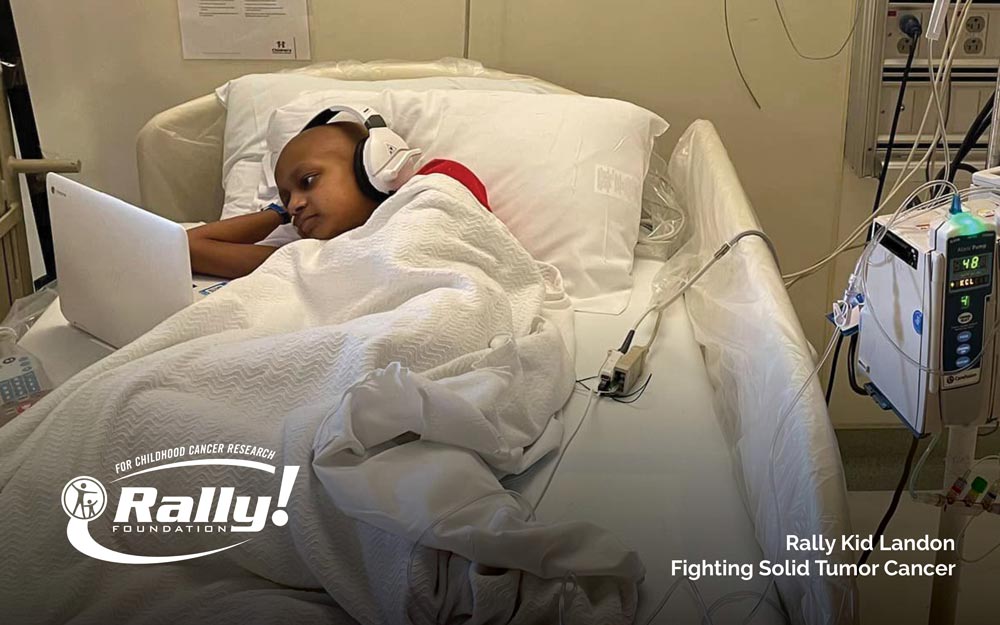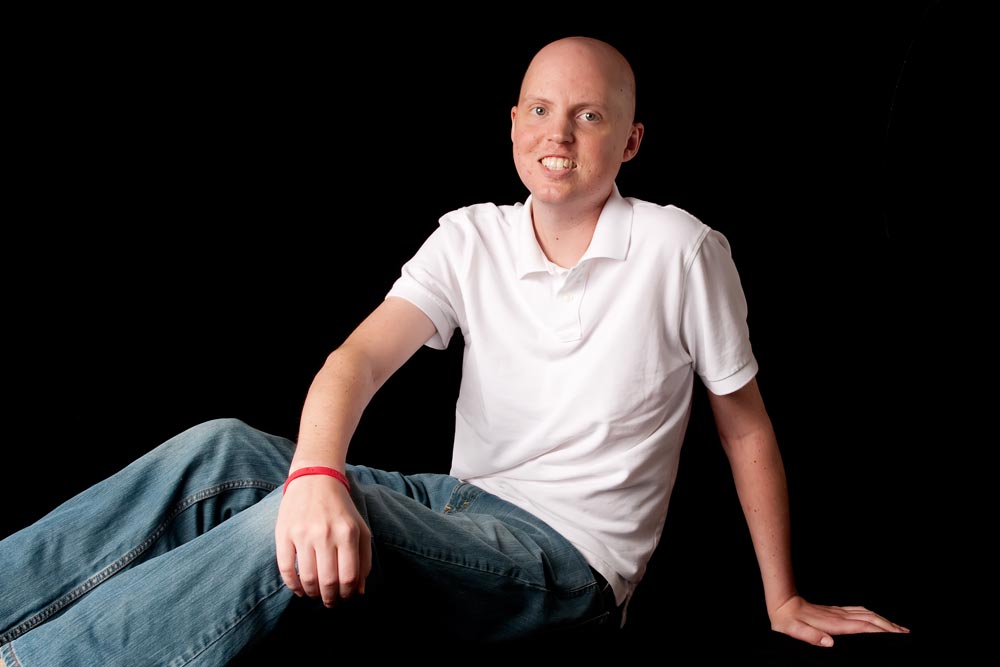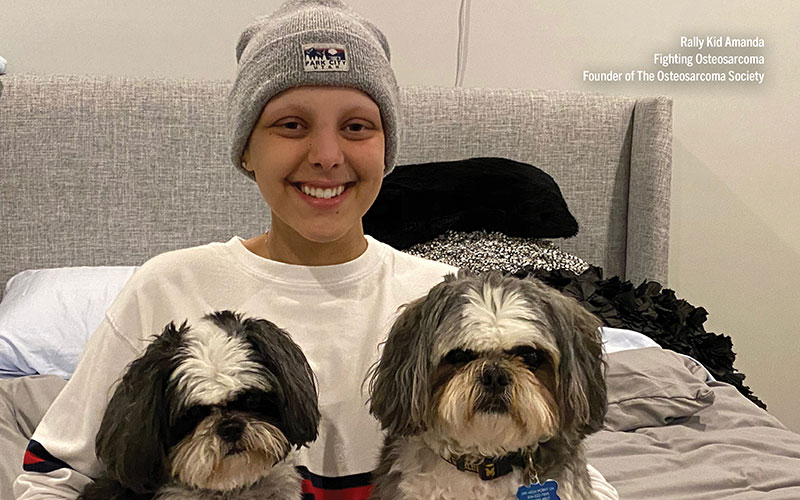Volunteers are the heart of Rally's mission!


Neuroblastoma is a cancerous tumor that develops in the nervous system of babies and young children. It can also occur, rarely, in adolescents. A neuroblastoma tumor often affects immature nerve tissue called neuroblasts. The most common area for neuroblastoma to appear is in the adrenal glands, which sit above the kidneys. Adrenal glands produce hormones that control body functions such as digestion, blood pressure, breathing and heart rate. Neuroblastoma can also begin in other areas of the body such as the chest, neck, spine or spinal cord, or abdomen. Neuroblastoma is the most common cancer in babies and can even occur before birth. It almost always develops in children before the age of 5. Neuroblastoma accounts for about 10% of childhood cancers. A very small percentage of neuroblastoma cases are hereditary, which is determined through genetic testing for those patients with a...

Atypical Teratoid/Rhabdoid Tumor (AT/RT) is a rare and fast-growing tumor that typically originates in the brain and spinal cord. These tumors most often occur in the part of the brain called the cerebellum, which controls movement and balance, or in the brain stem, which controls vital functions like breathing and heart rate. AT/RT mainly occurs in children under the age of three, but it can occur in older children and very rarely in adults. AT/RT is found in fewer than 3% of children with brain tumors. In most cases, AT/RT is associated with a specific genetic mutation in the SMARCB1 or SMARCA4 genes. These genes make a protein that helps control cell growth. About 10% of AT/RT cases have a hereditary genetic abnormality that increases the risk of developing AT/RT. AT/RT SIGNS AND SYMPTOMS AT/RT symptoms vary depending on the tumor’s size and location as well as the child’s age....

It’s been fifteen and a half years since a malignant tumor the size of a grapefruit was removed from the left kidney of our son, James. The feelings of despair and the fear of losing our eleven-year-old constantly gnawed at our hearts. Every time I meet a parent of a child faced with cancer, I empathize deeply with them. As James’s treatment progressed, we muddled through the pains and disruption of surgeries, tests and multiple days and nights in the hospital. It dawned on us that, while this chapter in our lives was difficult, there were many families on the oncology floor going through much worse. First, James had the benefit of being a part of a research trial, which gave us added hope that he could beat this dreadful disease. Many parents are told the only protocol available for their child is the same old treatment that has been around for decades. (Childhood cancer research is...

Diffuse intrinsic pontine glioma (DIPG) is a brain tumor found in a part of the brain stem—above the back of the neck and connected to the spine—called the pons. The pons is a vital part of the brain, controlling critical bodily functions like breathing, swallowing, blood pressure, heart rate, eyesight and balance. DIPG occurs almost exclusively in children; most often between the ages of four and 11. DIPG accounts for roughly 10-15% of all brain tumors in children. These tumors—called gliomas because they grow from glial cells—permeate healthy brain tissue and cause severe symptoms. DIPG is classified into four stages, with Grade III and IV being the most aggressive. DIPG SIGNS AND SYMPTOMS Children with DIPG typically experience double vision, loss of balance and clumsiness, weakness in the arm and legs, nausea and vomiting, headaches (especially in the morning) and difficulty with...

Medulloblastoma is a type of brain cancer that’s most commonly found in children. “Medulloblastoma starts in the cerebellum, which is located in the back of the brain,” explained Rally-funded Researcher Dr. Jezabel Rodriguez-Blanco, Assistant Professor, Department of Pediatrics at the Medical University of South Carolina. “It is a fast-growing tumor that often compresses the ventricle that brings the protective cerebrospinal fluid to the brain. The cerebellum is the part of the brain that controls balance, coordination, speech and other motor functions. Medulloblastoma can spread through the fluid that surrounds your brain, called cerebrospinal fluid (CSF), and affect the areas around the brain and spinal cord. Rarely does it spread to other parts of the body. “Medulloblastoma has been one of the most molecularly interrogated pediatric tumors,” said Rally-funded Researcher Dr. Vidya...

During this pandemic, my mantra has been “adjust and readjust.” I have shared that I learned this from the Rally families who never cease to amaze me with how often and quickly they adjust and readjust. Today, I stand in awe of 17-year-old Rally Kid Amanda and how she has adjusted and readjusted. Less than a year ago, she was diagnosed with osteosarcoma, a type of bone cancer. She was a junior in high school at the time. Amanda has endured so much: a horrific, intense and painful treatment protocol that has not gone smoothly, surgery to remove part of her leg and replace it with a titanium rod, a full knee replacement and the loss of her hair. Amanda met two other teenage girls, Ellie and Catherine, who were also fighting the osteosarcoma beast. They become the “Osteo Trio”—supporting each other and becoming great friends. A couple months ago, the Osteo Trio lost one of their own,...

Neuroblastoma is a cancerous tumor that develops in the nervous system of babies and young children. It can also occur, rarely, in adolescents. A neuroblastoma tumor often affects immature nerve tissue called neuroblasts. The most common area for neuroblastoma to appear is in the adrenal glands, which sit above the kidneys. Adrenal glands produce hormones that control body functions such as digestion, blood pressure, breathing and heart rate. Neuroblastoma can also begin in other areas of the...

Atypical Teratoid/Rhabdoid Tumor (AT/RT) is a rare and fast-growing tumor that typically originates in the brain and spinal cord. These tumors most often occur in the part of the brain called the cerebellum, which controls movement and balance, or in the brain stem, which controls vital functions like breathing and heart rate. AT/RT mainly occurs in children under the age of three, but it can occur in older children and very rarely in adults. AT/RT is found in fewer than 3% of children with...

It’s been fifteen and a half years since a malignant tumor the size of a grapefruit was removed from the left kidney of our son, James. The feelings of despair and the fear of losing our eleven-year-old constantly gnawed at our hearts. Every time I meet a parent of a child faced with cancer, I empathize deeply with them. As James’s treatment progressed, we muddled through the pains and disruption of surgeries, tests and multiple days and nights in the hospital. It dawned on us that, while this...

Diffuse intrinsic pontine glioma (DIPG) is a brain tumor found in a part of the brain stem—above the back of the neck and connected to the spine—called the pons. The pons is a vital part of the brain, controlling critical bodily functions like breathing, swallowing, blood pressure, heart rate, eyesight and balance. DIPG occurs almost exclusively in children; most often between the ages of four and 11. DIPG accounts for roughly 10-15% of all brain tumors in children. These tumors—called gliomas...

Medulloblastoma is a type of brain cancer that’s most commonly found in children. “Medulloblastoma starts in the cerebellum, which is located in the back of the brain,” explained Rally-funded Researcher Dr. Jezabel Rodriguez-Blanco, Assistant Professor, Department of Pediatrics at the Medical University of South Carolina. “It is a fast-growing tumor that often compresses the ventricle that brings the protective cerebrospinal fluid to the brain. The cerebellum is the part of the brain that...

During this pandemic, my mantra has been “adjust and readjust.” I have shared that I learned this from the Rally families who never cease to amaze me with how often and quickly they adjust and readjust. Today, I stand in awe of 17-year-old Rally Kid Amanda and how she has adjusted and readjusted. Less than a year ago, she was diagnosed with osteosarcoma, a type of bone cancer. She was a junior in high school at the time. Amanda has endured so much: a horrific, intense and painful treatment...